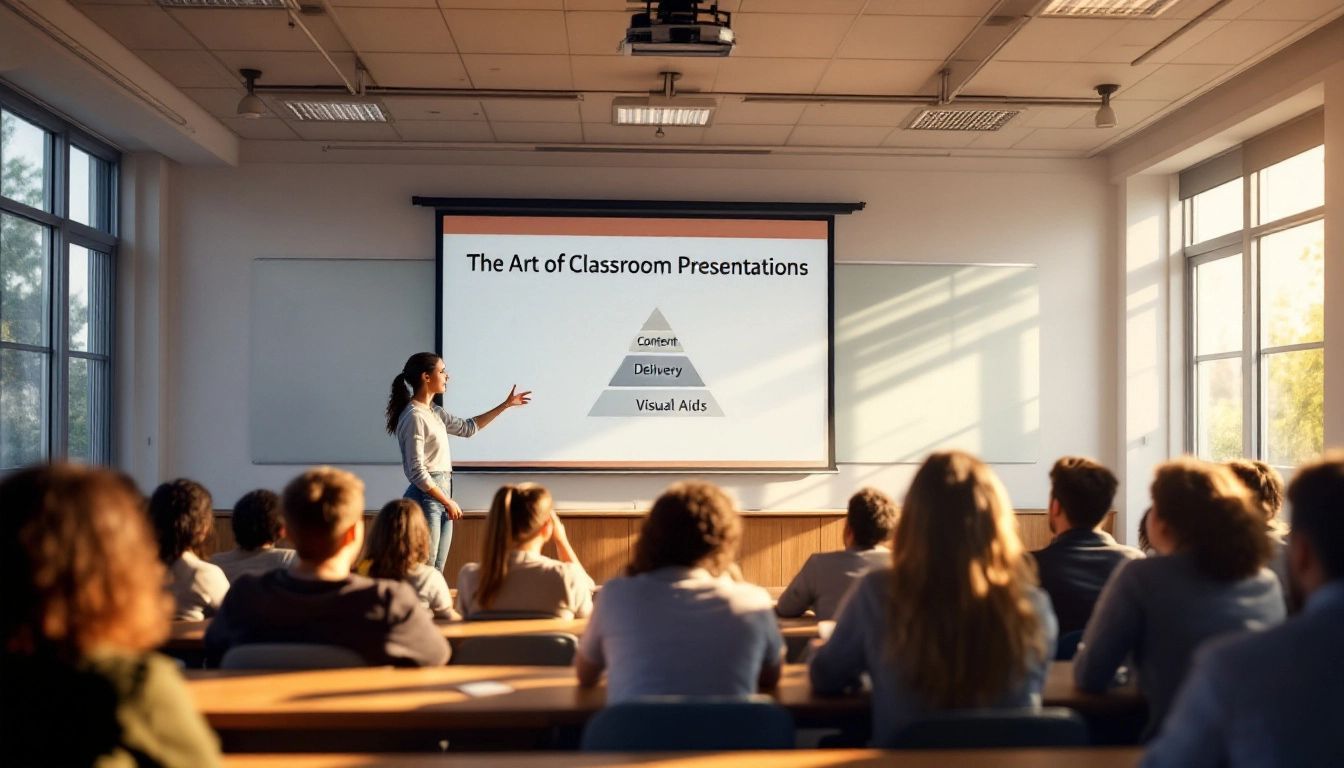Speaking in front of your classmates might feel intimidating at first, but presenting is a crucial part of succeeding in school. It's about sharing what you know, becoming more confident, and taking ownership of your ideas. Imagine it this way: you've learned something new, and now you get to be the teacher!
Presentations that work well are about more than just facts. They grab your audience's attention and make them curious. When you present effectively, you're not just reciting information; you're telling a story. This is your time to take the lead and make a topic your own.

Preparation Techniques
The secret to acing any presentation, especially in front of your class, is preparation. This means doing your research, organizing your thoughts, and practicing until you're comfortable.
Start by becoming an expert on your topic. Go beyond the textbook and explore different perspectives. What questions would someone ask if they were learning this for the first time? For instance, if you're presenting on the American Revolution, don't just focus on dates and battles. Delve into the motivations of both sides and the impact it had on the world.
Once you feel good about the material, structure your presentation in a way that makes sense. Think of it like a good story: it needs a beginning, middle, and end. Grab your audience's attention from the start, then clearly present your main points, and finish with a strong conclusion.
Finally, practice! Rehearse in front of a mirror, your family, or even your pets. This helps you get comfortable with the material and find areas that need work. The more you practice, the more confident you'll be when you're standing in front of your class.
Effective Visual Aids

Visual aids are important tools for presentations. They can transform an ordinary presentation into something engaging. Your slides or handouts should support your presentation.
Slides that Stand Out
Slides should complement what you're saying, not replace it. Keep them clean, concise, and use bullet points to highlight key ideas. Include visuals that enhance your message, like images, charts, or even short videos. If you wouldn't want to stare at a slide for too long, neither will your classmates.
For example, if your presentation is about the rainforest, don't just talk about the variety of life there—show it! Include pictures of amazing plants and animals.
Handouts: More Than Just Paper
Handouts give your audience something to take away from your presentation. Don't just copy your slides; offer additional information or thought-provoking questions. Think of it as giving your classmates the tools to keep exploring the topic even after your presentation is over.
Consider including a glossary of terms, a timeline of events, or discussion questions. This keeps your classmates engaged even after you've finished presenting.
Want to create amazing presentations that impress your classmates? Check out GenPPT! This innovative tool helps you make professional-level presentations quickly, giving you more time to focus on your content and delivery. Try Genppt to learn more.
Delivering with Confidence
You've done the hard work—now it's showtime! Presenting in front of your class can feel nerve-wracking, but remember that you've prepared!
- Own the Room: Stand tall, make eye contact, and speak clearly and loudly enough for everyone to hear you. The classroom is your stage!
- Channel Your Nervous Energy: It's normal to be nervous. Take a deep breath and let that nervous energy fuel your enthusiasm.
- Connect with Your Classmates: This isn't just about presenting information; it's about sharing it with your peers. Make eye contact, smile, and let your personality show.
- Pace Yourself: Speak at a comfortable pace, and don't be afraid to pause. Silence can be effective—it gives you and your audience time to think.
- Embrace Imperfection: It's okay to make a mistake. What matters most is that you're engaged with the material and sharing what you know confidently.
The more you present, the easier it gets. Remember, everyone starts as a beginner.
Engaging Your Audience

Think about the best presentations you've seen. What made them so interesting? It likely wasn't just the information itself but how it was presented. Engaging your audience means turning a regular talk into a learning experience you share together.
Interaction is Key
Imagine watching a movie where no one talks—boring, right? The same applies to presentations. Your classmates are more than just an audience; they're active participants.
Include moments for interaction. Ask open-ended questions about your topic. For example, instead of just listing the causes of World War I, ask, "What were some things that made war almost unavoidable?" Encourage a short discussion and ask your classmates to share their thoughts.
Activities That Bring Your Topic to Life
Don't be afraid to get creative! Short, relevant activities can make your presentation more dynamic. If you're presenting on different types of rocks, bring in samples for your classmates to examine. If your topic is a book, have small groups analyze a key passage together.
Remember, the goal is to deepen understanding and encourage active listening, not to turn your presentation into a game show.
Mastering the Q&A
The question-and-answer part is your time to shine as an expert. It shows you've thought deeply about your topic.
- Anticipate Questions: Think about questions your classmates might have while you're preparing.
- Listen Carefully: Pay attention to the questions. This shows respect and ensures you understand what they're asking.
- Keep it Concise: Answer clearly and directly. There's no need to over-explain.
- It's Okay to Say "I Don't Know": Honesty is important. If you don't know an answer, offer to research it.
Presenting is a chance to create a dynamic and memorable experience. Encourage interaction, incorporate activities, and master the Q&A.
Post-Presentation Reflection
You did it! Now it's time to think about what worked, what could be better, and how you can improve for next time.
Think about the moments that went well. Did a specific point spark a lot of discussion? Did a certain visual really grab your classmates' attention? Conversely, were there parts where you felt less confident or the audience seemed less engaged?
Don't be afraid to ask your teacher and classmates for feedback. Ask them for specific and helpful comments. Did your slides work well? Was your presentation engaging?
Take this feedback and use it to improve. Maybe you want to try different types of visuals or practice your delivery. Every presentation is a learning opportunity. By embracing reflection and continuous improvement, you'll become a more confident and engaging presenter.
